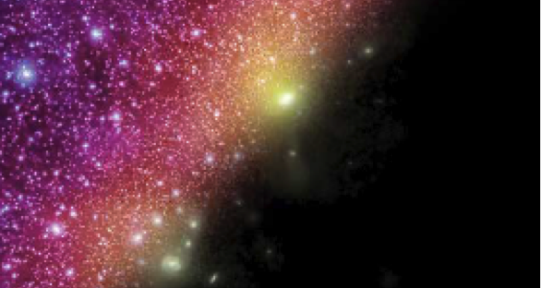The APOSTLE simulations: A Local Universe laboratory

Dark matter and stellar component in a region of the universe resembling the Local Group, simulated at high resolution as part of the APOSTLE project. Luminous and dark matter distribution show a dramatic difference in the Local Group. Detail of an image by Dr. Till Sawala.
By K. Oman & S. Monty
Cosmology probes the very fundamentals of the creation, history and evolution of the Universe. Conceived in the 1990s, the Lambda-Cold Dark Matter (LCDM) theory is now the “standard model” of cosmology. Its predictions regarding the formation of structure in the Universe across a wide range of scales and epochs, from the very early Universe to the present, have been borne out of both state-of-the-art observational surveys and computer simulations. Where these two methods disagree is in observations of the Local Group (LG) of galaxies—comprised of the Milky Way, the Andromeda galaxy, and more than 50 nearby dwarf galaxies. For instance, LCDM predicts a multitude of relatively small dark matter clumps should be orbiting the Milky Way, each in principle able to host a galaxy. Yet the Milky Way has only a handful of galaxies surrounding it; where are its “missing satellites”? Are there less clumps than the theory predicts, or is the process of galaxy formation only able to proceed in some special subset of the clumps?
These and other unresolved puzzles have prompted UVic Professor and ARC faculty member Dr. Julio Navarro and his collaborators, including UVic graduate students Azadeh Fattahi and Kyle Oman and international collaborators in the UK and Finland, to undertake A Project On Simulating The Local Environment (APOSTLE), begun in 2013. They have selected 12 regions from a low-resolution simulation of a large volume of the Universe—each chosen to resemble the LG in terms of total mass, distance separating two galaxies analogous to the Milky Way and Andromeda, and the kinematics of the same pair. Each region was then simulated at high resolution, tracing the evolution of up to 20 million particles from a time before the formation of the first stars to the present day, using the cutting-edge hydrodynamic simulation software and galaxy formation physics developed for the EAGLE project. The end result is a richly detailed picture of the two giant galaxies, complete with their spiral disks, stellar halos and streams, and orbiting satellite galaxies, and their broader environment out to a distance of 2 Mpc.
The first important result to emerge from the simulations was the recovery of the stellar mass function of LG galaxies: the number of galaxies as a function of mass in the Local Volume. Prior to the APOSTLE simulations, the LCDM model had failed to predict the observed abundance of galaxies within the LG. The EAGLE model, a product of the EAGLE cosmological simulations, was calibrated to reproduce the stellar mass function for massive galaxies, but there was no guarantee that the same physical assumptions would yield a realistic population of dwarf galaxies when the code was used for much higher resolutions simulations. The APOSTLE team has now demonstrated that the combination of LG-like initial conditions and a properly motivated and calibrated model of galaxy formation physics prevents many dark matter clumps from forming galaxies and reproduces the right number of LG galaxies, thus resolving the puzzle of the “missing satellites”.
Since the publication of this initial result, many more researchers from around the world have taken an interest in analyzing the APOSTLE data. There are now more than 40 completed and ongoing projects in the collaboration on a wide range of topics, from the nature and properties of dark matter to the stellar populations of the Milky Way and its satellites, from the large-scale local distribution of intergalactic gas to how the masses of the smallest galaxies are measured. As the APOSTLE team continues to examine the results of these remarkable simulations, the LCDM model will be put to the test, answering existing questions and raising new ones.
For more information on the APOSTLE collaboration and relevant publications please visit: blogs.helsinki.fi/sawala/the-apostle-collaboration/
